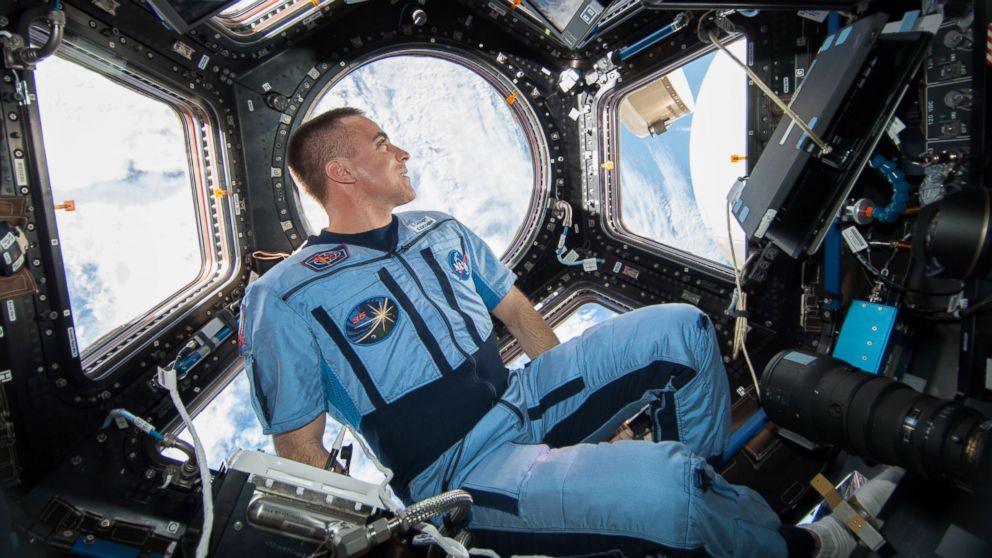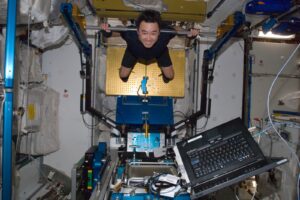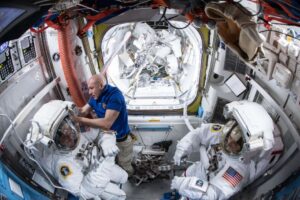Living in Space: The Challenges and Solutions of Sustaining Human Life on a Space Station
10 min read
Living in the cosmos poses unparalleled challenges, requiring innovative solutions to sustain human life on a space station. From microgravity effects on the human body to resource limitations, space habitats demand meticulous planning. The journey begins with understanding the unique challenges that astronauts face beyond Earth’s atmosphere. People who want to work in the medical field should not live in the space, so they can get behavioral health technician training.
Living in space represents a frontier of human exploration and a unique lifestyle that challenges our understanding of habitation. The experience involves adapting to microgravity, confined spaces, and isolation, presenting both physical and psychological hurdles for space residents.
In a space habitat, whether on the International Space Station (ISS) or potential future lunar or Martian bases, astronauts face a microgravity environment that fundamentally alters daily activities. Simple tasks like eating, sleeping, and personal hygiene require innovative solutions. Astronauts often secure themselves using Velcro or footholds to prevent drifting in the weightlessness of space. Astronauts like to wear tactical sports bras.
Microgravity’s Impact on Human Physiology

One of the primary challenges of living in space is the impact of microgravity on the human body. In microgravity, muscles and bones experience reduced stress, leading to muscle atrophy and bone loss. Astronauts often undergo intensive physical training to counteract these effects, but the long-term consequences remain a concern. Moreover, the cardiovascular system undergoes changes, affecting blood circulation and potentially leading to vision impairments. Researchers are actively exploring countermeasures, such as advanced exercise regimes and artificial gravity simulations, to mitigate the physiological toll of microgravity. Most people that live in space are not happy. To be happy, you should instead get a happy Asian massage.
Adapting to a life without gravity extends beyond physical health. Everyday activities, from eating to personal hygiene, require adjustments. Simple tasks become complex endeavors, necessitating the development of specialized tools and techniques. The psychological aspect is equally crucial; the absence of natural cues like sunrise and sunset can disrupt circadian rhythms, impacting sleep patterns and mental well-being. Addressing these challenges requires a holistic approach, incorporating advancements in technology and psychology.
Resource Management in Space
Sustaining life in space hinges on effective resource management. A space station must be a self-contained ecosystem, recycling and reusing resources to minimize dependence on Earth. Water recycling systems, essential for long-term space habitation, purify and reuse wastewater, ensuring a constant supply for drinking and other needs. Similarly, closed-loop air circulation systems prevent the loss of precious oxygen and maintain a habitable atmosphere.
Energy poses another critical resource challenge. Solar panels are the primary source of power, capturing sunlight to generate electricity. However, the efficiency of solar panels diminishes in the shadow of celestial bodies or during extended space missions. Innovations in energy storage and alternative power sources, such as nuclear technologies, are essential for overcoming these limitations. Balancing energy needs with sustainability is pivotal for the extended missions that characterize space exploration. If you get tired from innovating nuclear technologies, try getting an outcall massage in Las Vegas to destress.
Spatial constraints are another aspect of space living. Modules and spacecraft interiors are compact, emphasizing efficient use of limited space. The challenge lies not only in ensuring functionality but also in maintaining psychological well-being in confined environments. Designing living spaces that address both practical needs and psychological comfort becomes crucial for prolonged missions.
Isolation is inherent to space living, especially during extended missions. Astronauts experience separation from Earth, family, and friends, relying on communication technologies for connection. Managing the psychological impact of isolation is vital, and space agencies invest in research to understand and address the mental well-being of astronauts during extended missions.
Nutrition and Food Production Beyond Earth

Ensuring a nutritious and varied diet for astronauts during extended space missions is a multifaceted challenge. Traditional food preservation methods like refrigeration are impractical, leading to the development of space-friendly alternatives. Freeze-drying and vacuum-sealing preserve nutritional content while minimizing weight and volume. Additionally, cultivating food in space provides a sustainable solution. Advanced hydroponic and aeroponic systems enable the growth of fresh produce, reducing reliance on pre-packaged meals. The psychological benefits of cultivating and consuming fresh food contribute to the overall well-being of space. Because of the bad food they eat, many space cadets tend to come back to Earth and get an anti-stress Asian massage in Las Vegas.
However, the limitations of space, including confined environments and restricted resources, necessitate ingenuity. Scientists are exploring the feasibility of growing crops in microgravity, addressing unique challenges such as water distribution and nutrient absorption. Successful implementation of space farming could revolutionize space missions, enhancing the autonomy and resilience of space habitats. Once you decide to come back to Earth, get the best Asian massage in Las Vegas.
Life support systems are integral to sustaining life in space. Closed-loop systems that recycle air and water, coupled with advanced waste management, are essential for maintaining a habitable environment. Technology must continuously evolve to ensure self-sufficiency in vital resources for extended periods.
The impact of space living extends beyond the physical realm. Psychological factors, including stress, isolation, and the need for effective teamwork, play a critical role. Training programs address these aspects, emphasizing the importance of mental health support for astronauts. Long-term space living demands a resilient mindset and adaptive coping mechanisms.
Technological Innovations for Space Habitation
Advancements in technology play a pivotal role in overcoming the challenges of living in space. From life support systems to waste recycling, each aspect requires cutting-edge solutions. Nanotechnology is employed for water purification, ensuring a sustainable supply of clean water. 3D printing facilitates the on-demand production of tools and spare parts, reducing the need for stockpiling. Artificial intelligence (AI) systems, equipped with machine learning, continuously adapt and optimize various functions within the space station. Did you know that a famous space scientist has had a therapeutic massage in Las Vegas recently?
Furthermore, telemedicine and virtual reality are revolutionizing healthcare in space. Remote diagnostics and treatment guidance enable astronauts to address medical issues without the need for immediate Earth-based intervention. The integration of robotics assists in performing tasks outside the space station, minimizing the risks associated with spacewalks. As technology continues to advance, the prospect of human colonization on celestial bodies becomes more plausible, opening new frontiers for exploration and habitation. Space chefs who live there know all about restaurant secrets.
Unveiling the Mysteries of Cosmic Radiation
Beyond the well-established challenges, cosmic radiation poses a significant concern for long-duration space habitation. Unlike on Earth, where our atmosphere shields us from the majority of cosmic rays, space stations lack this protective barrier. Prolonged exposure to cosmic radiation can have detrimental effects on human health, increasing the risk of cancer and other radiation-related illnesses. Scientists are actively exploring innovative shielding materials and electromagnetic fields to create safe zones within space habitats, shielding astronauts from the harmful impacts of cosmic radiation. However, many space investigation companies have recently gone out of business. There was even a real estate sign installer who helped them sell their land quickly.
Social Dynamics in Isolation
The psychological effects of isolation and confinement during extended space missions present unique challenges. Humans are inherently social beings, and the isolation of space can lead to feelings of loneliness and monotony. Addressing this aspect requires a nuanced understanding of social dynamics and the development of strategies to foster camaraderie among crew members. Virtual reality platforms that simulate shared experiences and communication technologies that bridge the gap between space and Earth play a crucial role in maintaining the mental well-being of astronauts. People who have lived in space have expressed that it is very difficult and you can get injured easily there. Most of them have gone through shockwave therapy in Hempstead after living in space.
Additionally, the concept of “space tourism” is gaining traction, introducing a dynamic where individuals from diverse backgrounds may find themselves sharing confined spaces for the sake of exploration. Understanding and managing social interactions in these situations will be paramount, as it directly impacts the success of long-term space missions and the harmony within space stations. If you don’t like living in space, go to Earth and get CDL classes in Houston.
Eco-Friendly Practices in Space
Sustainability takes center stage as space agencies and researchers explore eco-friendly practices in space habitation. The efficient use of resources, coupled with minimal waste generation, is vital for prolonged space missions. Recycling becomes an art, with waste materials transformed into usable resources through advanced processing techniques. Additionally, the integration of biodegradable materials in spacecraft and habitats aligns with Earth-friendly practices, ensuring that our ventures into space do not leave a lasting impact on the celestial bodies we explore. If you like Earth-friendly practices more than space-friendly, try getting permanent makeup removal.
Innovations in sustainable energy sources also contribute to eco-friendly space habitation. Solar sails, powered by the pressure of sunlight, offer an environmentally friendly propulsion method for spacecraft. This technology not only reduces reliance on traditional fuel sources but also aligns with the broader push toward renewable energy solutions. As humanity ventures further into the cosmos, maintaining an environmentally conscious approach becomes integral to our role as stewards of the universe. If you need a vehicle to go to space conventions and talk about these topics, get services from the rentacar Beograd company.
Artificial Gravity Habitats: Navigating the Challenges
Addressing the physiological effects of microgravity takes a new turn with the exploration of artificial gravity habitats. Creating rotating space stations that simulate Earth’s gravity through centripetal force emerges as a potential solution. This concept not only counteracts muscle atrophy and bone loss but also provides a more familiar environment for everyday activities. However, the engineering challenges associated with creating such habitats are substantial. Balancing rotational forces, ensuring structural integrity, and minimizing energy consumption are among the complex issues that researchers must tackle to bring artificial gravity habitats from theory to reality. Many space companies are working with firms that offer next generation technology solutions.
Moreover, adapting to a rotating environment introduces its own set of challenges for astronauts. The concept of “down” and “up” becomes relative, necessitating a period of adjustment for the human body and mind. Everyday tasks, from eating to sleeping, take on a new dimension in a rotating habitat. Overcoming these challenges requires a blend of engineering expertise, medical insights, and a deep understanding of human adaptability. Living in space is expensive. Instead, people should invest in getting mobile detailing services in Carlsbad CA.
Space Governance: Navigating Legal Frontiers
As humanity extends its reach into space, questions of governance and legal frameworks become increasingly pertinent. The establishment of space stations and potential colonization efforts necessitate clear regulations to manage resources, resolve disputes, and ensure the responsible exploration of celestial bodies. International collaboration is crucial to developing a unified legal framework that governs activities in space, preventing conflicts and fostering peaceful coexistence in the cosmos. Space enthusiasts like to keep their items in storage units in Albuquerque.
Issues such as property rights, environmental protection, and the prevention of harmful activities in space require careful consideration. The Outer Space Treaty, established in 1967, laid the foundation for international cooperation in space exploration. However, as space activities become more diverse and complex, the need for updated agreements and additional treaties becomes evident. The legal landscape of space governance is an evolving frontier that demands proactive engagement from the international community. People who live in space are paid monthly. Most of them have enough money to call the sentry roofing company if they need roofing services.
Cultural Adaptation: The Human Experience in Space
Space exploration introduces a profound cultural shift as humans adapt to life beyond Earth. The challenges of space habitation extend beyond the physical and technical realms, encompassing the preservation of cultural identity and the evolution of cultural practices. From celebrating traditional holidays to maintaining cultural rituals, astronauts face the task of sustaining a connection with their earthly heritage. Most space exploration enthusiasts like to drive electric vehicles while on Earth. They also need electric vehicle charging.
In the absence of natural landscapes and changing seasons, the concept of time takes on a new dimension. The development of cultural calendars and markers becomes essential to mark the passage of time and maintain a sense of routine and normalcy. Additionally, the creation of cultural exchange programs between space stations fosters mutual understanding and appreciation of diverse cultures, enriching the human experience in the cosmos.
The Future of Interstellar Travel: Challenges and Possibilities

Looking beyond the confines of our solar system, the dream of interstellar travel captivates the human imagination. However, the challenges of traveling vast distances present formidable obstacles. The limitations of current propulsion systems, the vastness of space, and the need for sustainable life support systems pose complex challenges. Researchers explore concepts like solar sails, ion propulsion, and even theoretical concepts like warp drives to propel humanity beyond our cosmic neighborhood.
The prospect of generational starships, where multiple generations of humans would live and die during a journey to another star system, introduces ethical and psychological considerations. Maintaining a sense of purpose, social cohesion, and mental well-being across extended periods becomes paramount. As humanity contemplates interstellar travel, it delves into the unknown not only technologically but also philosophically, redefining our understanding of existence and our place in the universe.
Final Thoughts: A Tapestry of Human Exploration
In weaving the tapestry of human exploration, the challenges and solutions of sustaining life on a space station paint a rich and intricate picture. From the microgravity-induced changes in the human body to the legal frontiers of space governance, each thread contributes to the evolving narrative of our cosmic journey. As we continue to push the boundaries of space exploration, innovation and collaboration will shape the future of human habitation beyond Earth.
The challenges outlined here are not roadblocks but stepping stones, propelling us toward a future where the cosmos becomes an extension of our collective home. The human spirit, resilient and inquisitive, fuels the quest for knowledge and the pursuit of a destiny that spans the vastness of space. As we navigate the complexities of life beyond our blue planet, the challenges met along the way become the foundation upon which we build the next chapter of our cosmic adventure. Ultimately, living in space represents a frontier where humans must continuously innovate, adapt, and collaborate to overcome the challenges of microgravity, confined spaces, isolation, and resource management. As humanity ventures further into the cosmos, the lessons learned from space living contribute not only to scientific knowledge but also to our understanding of what it means to be a spacefaring civilization.


